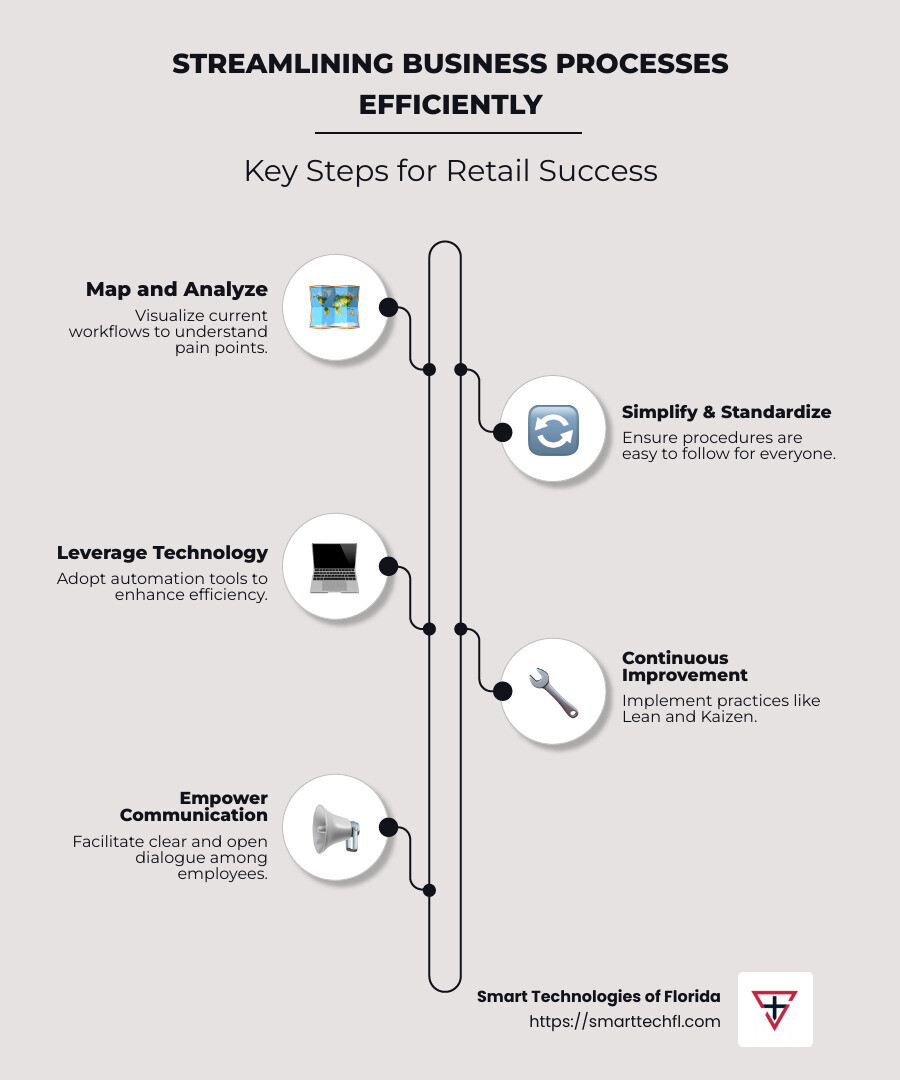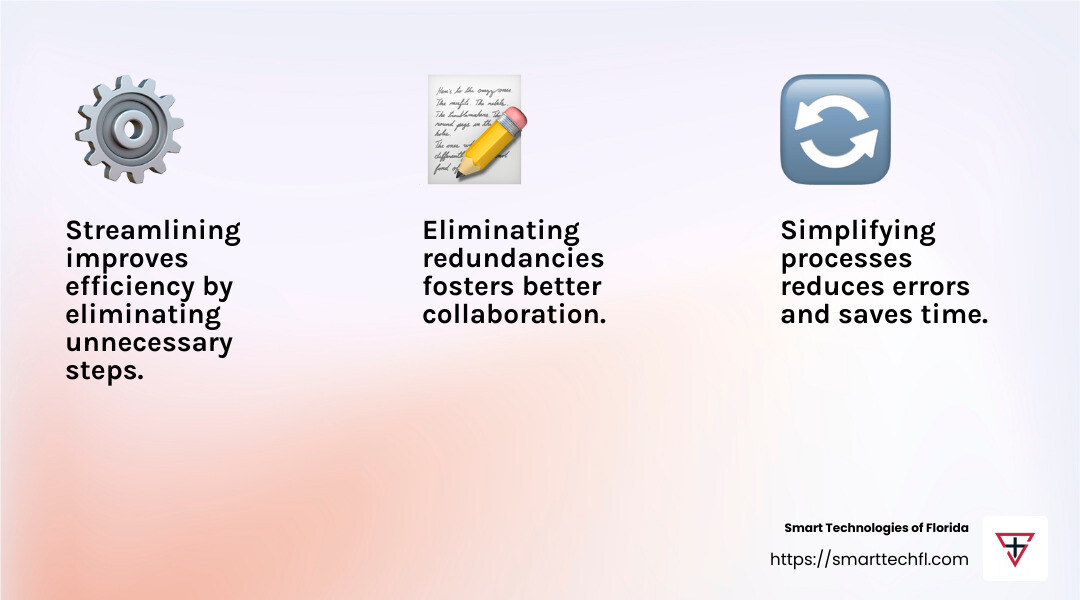A Step-by-Step Guide to Business Efficiency
How to streamline business processes effectively can significantly impact your business’s success, especially if you are the owner of a mid-sized retail company looking to improve operational efficiency and customer engagement. Here’s a quick overview:
- Map and analyze current workflows
- Simplify and standardize procedures
- Leverage technology and automation tools
- Engage in continuous improvement practices like Lean and Kaizen
- Focus on clear communication and employee empowerment
In today’s business environment, maintaining efficient processes is not just a strategy—it’s a necessity. Efficient processes reduce waste, save time, and eliminate errors. They pave the way for increased productivity and operational excellence, positioning your business for growth and success.
As a retail business owner, outdated technology and high operational costs might slow you down. Streamlining your business processes allows you to cut through these barriers, reduce costs, and boost overall performance. By doing so, you are not only making your operations more efficient but also ensuring that your staff remain empowered. Employees should see new technologies as tools that help them, not as a threat to their job security.
Streamlining business processes helps you adapt swiftly to market changes and align better with evolving customer expectations. Each step optimized today makes your business more agile and competitive tomorrow.

What is Streamlining Processes?
Streamlining processes is all about making things simpler and more efficient. Imagine your business as a machine. Over time, parts of it might become rusty or clogged with unnecessary steps. Streamlining is like giving this machine a tune-up, so it runs smoothly and efficiently.
Process Optimization
At its core, streamlining is about process optimization. This means taking a close look at what your business does daily and finding ways to do it better. Optimization involves identifying the most critical steps in your processes and ensuring they are as effective as possible. It’s about making sure every action adds value and contributes to your business goals.
Simplification
Simplification is a big part of streamlining. It’s about cutting out the clutter and focusing on what’s essential. For example, if placing a purchase order involves five different forms, simplification might mean consolidating those into one easy-to-use form. This not only saves time but also reduces the chance of errors.
Eliminating Redundancies
Eliminating redundancies is another crucial aspect. Redundancies are like the extra steps that don’t need to be there. They slow things down and can lead to confusion. By identifying and removing these unnecessary steps, you can make your processes more direct and efficient.
For instance, if two departments handle similar tasks separately, you might combine their efforts, saving time and resources. This approach not only streamlines the workflow but also fosters better collaboration and communication.

In summary, streamlining processes involves looking at your business operations with a critical eye. By optimizing, simplifying, and eliminating redundancies, you can create a more agile and responsive business environment. This change not only improves productivity but also positions your company to better meet customer needs and adapt to market changes.
This focus on efficiency leads us to explore how to streamline business processes effectively.
How to Streamline Business Processes
Streamlining business processes is like cleaning up your workspace. It makes everything clearer, faster, and more productive. Let’s explore three key strategies to make this happen: process mapping, workflow analysis, and automation.
Process Mapping
Process mapping is your starting point. Think of it as creating a blueprint for your business operations. You lay out every step in a process to see the big picture. This visual representation, often in the form of flowcharts or diagrams, helps identify who does what and when.
One popular tool is the SIPOC diagram, which stands for Suppliers, Inputs, Process, Outputs, and Customers. This tool gives a clear overview of the entire process, highlighting where improvements can be made.

Why map processes? It helps you find inefficiencies and areas for improvement. For example, if you notice that two departments have overlapping responsibilities, you can streamline by combining these tasks into one.
Workflow Analysis
Once you have your process map, it’s time for workflow analysis. This involves digging deeper into each step to evaluate its value. Ask yourself:
- Are there any bottlenecks slowing things down?
- Are there steps that don’t add value and can be eliminated?
- How are tasks handed off between teams?
By answering these questions, you can identify areas to improve efficiency. For instance, if a task takes too long due to manual data entry, consider automating it.
Automation
Automation is the game-changer. By using technology to handle repetitive tasks, you free up time for more important work. Automation reduces errors and speeds up processes.
Consider this: a small grocery store once had staff pick items for customers. They switched to letting customers pick their own, inspired by Piggly Wiggly’s self-service model. This change not only sped up the process but also improved customer satisfaction.
Tools like CRM systems and workflow management software can automate tasks like data entry, customer follow-ups, and inventory management. Automation not only boosts productivity but also improves accuracy.
In summary, how to streamline business processes involves mapping out your current operations, analyzing them for inefficiencies, and then automating where possible. These steps help create a more efficient, cost-effective, and responsive business environment.
Next, we’ll explore the 10 Best Practices to Streamline Business Processes, ensuring your company not only keeps pace with change but leads the way.
10 Best Practices to Streamline Business Processes
Streamlining business processes is crucial for boosting efficiency and productivity. Here are ten best practices to help your organization achieve operational excellence.
Map Current Processes
Start by creating visual diagrams of your current processes. Use tools like flowcharts or SIPOC diagrams to lay out each step clearly. This visual map will help you see who is responsible for each task and pinpoint areas needing improvement. Identifying responsible employees ensures accountability and clarity in operations.
Tie Processes to Business Outcomes
Align each process with departmental goals and overall organizational alignment. This ensures that every step taken contributes to the company’s mission. If a process no longer fits with your goals, it’s time for a change. This alignment helps in prioritizing processes that drive business success.
Identify Areas of Improvement
Use product analytics to find bottlenecks and inefficiencies. Analytics can reveal where resources are wasted or where digital friction occurs. Prioritize these problem areas based on their impact on business outcomes. Focusing on high-impact areas first will yield better results.
Simplify and Standardize
Look for ways to create a uniform progression in your processes. Simplifying and standardizing steps makes it easier for employees to adopt new methods. For example, if one department handles a task more efficiently, standardize their process across the board to ensure consistency and ease of adoption.
Leverage Lean Principles
Adopt continuous improvement and waste elimination strategies from lean principles. This involves regularly reviewing processes to cut out unnecessary steps, reduce bottlenecks, and streamline workflows. Lean principles help in creating a culture of efficiency and value.
Improve Communication
Open channels for communication are vital. Regular process updates keep everyone informed and aligned. Use in-app messaging and other digital tools to ensure that all team members are on the same page. Effective communication minimizes misunderstandings and accelerates process adoption.
Provide Support in the Flow of Work
Use digital adoption platforms to offer support directly within employees’ workflow. This ensures that help is available when and where it’s needed, without disrupting productivity. In-app messaging can also provide real-time assistance and updates.
Test the New Workflow
Before rolling out a new workflow company-wide, conduct A/B testing in a live environment. This allows you to see how the new process performs compared to the old one. Testing helps catch potential issues early and ensures that the new workflow is effective and efficient.
Refine and Optimize
Once the new workflow is in place, continuously monitor metrics and update training as necessary. Regularly refining processes ensures they remain efficient and relevant. Keep an eye on performance indicators to spot areas for further improvement.
Focus on Customer Impact
Finally, always consider the customer service aspect of your processes. Streamlined processes should improve customer satisfaction and contribute to positive business outcomes. By focusing on the customer impact, you ensure that your processes not only run smoothly but also deliver value to your clients.
By following these best practices, your organization can transform inefficiencies into competitive advantages, driving sustained success in a demanding marketplace. Next, we’ll explore the Benefits of Streamlining Processes, highlighting how these improvements can lead to increased efficiency, cost reduction, and greater satisfaction for both employees and customers.
Benefits of Streamlining Processes
Streamlining business processes can transform how a company operates, offering significant advantages that ripple through every level of an organization. Let’s explore some key benefits:
Increased Efficiency
When processes are streamlined, tasks are completed faster and with less effort. This means employees can focus on more important work rather than getting bogged down by repetitive tasks. According to a Gallup poll, only 32% of U.S. workers were engaged in their jobs in 2015. Streamlining can boost this engagement by reducing errors and speeding up progress. Efficiency is not just about speed; it’s about doing things better, with fewer resources and less waste.
Cost Reduction
Reducing redundancies and automating tasks can significantly cut costs. Streamlining often involves digitization, which eliminates manual work and reduces the need for physical resources. This approach can lead to substantial savings, as businesses can allocate resources more effectively. By eliminating bottlenecks and silos, companies save time and money, which directly impacts the bottom line.
Improved Employee Satisfaction
When employees spend less time on mundane tasks, they are happier and more productive. Streamlined processes create a transparent working environment, promoting collaboration and teamwork. Employees are empowered to work independently and grow in their careers, leading to higher job satisfaction. By removing barriers to productivity, organizations can foster a more engaged and motivated workforce.
Improved Customer Satisfaction
Efficient processes lead to faster service delivery with consistent quality. This benefits both the organization and its customers. By reducing wait times and improving communication, companies can offer a better customer experience. Customers appreciate timely and efficient service, which can lead to increased loyalty and positive word-of-mouth. In a competitive market, customer satisfaction is a crucial differentiator.
Streamlining processes is not just about making things faster or cheaper; it’s about creating a more effective and satisfying experience for everyone involved. Up next, we’ll dig into the Methodologies for Streamlining Business Processes, exploring various frameworks and strategies to improve operational efficiency.
Methodologies for Streamlining Business Processes
Streamlining business processes is not just about cutting corners—it’s about using proven methodologies to improve efficiency and effectiveness. Let’s explore some of the most impactful methods:
Lean Management
Lean management is all about maximizing value by eliminating waste. Born from the Toyota Production System, this approach focuses on identifying what truly adds value to the customer and cutting out everything else. It’s a continuous journey of improvement, where processes are constantly tweaked to reduce waste and improve flow.
- Identify Value: Start by understanding what your customer values.
- Map Value Streams: Visualize your processes to spot inefficiencies.
- Create Flow: Ensure smooth operation without interruptions.
- Establish Pull: Produce only what is needed, when it’s needed.
- Pursue Perfection: Always look for ways to improve.
Six Sigma
Six Sigma aims for near perfection by reducing variability in processes. It uses data-driven techniques to minimize defects and improve quality. Six Sigma’s five-step process—Define, Measure, Analyze, Improve, Control (DMAIC)—guides organizations in refining their operations.
- Define: What is the problem?
- Measure: Gather data to understand the current state.
- Analyze: Identify the root causes of issues.
- Improve: Implement solutions to address these causes.
- Control: Maintain the improvements over time.
Business Process Reengineering (BPR)
BPR is a radical approach that involves rethinking and redesigning processes from the ground up. It’s about making dramatic improvements in critical areas like cost, quality, and speed. BPR is best for organizations facing deep-rooted inefficiencies.
- Focus on Outcomes: Understand what you want to achieve.
- Rethink Processes: Don’t just tweak—reimagine your operations.
- Use Technology: Leverage technology to transform processes.
Total Quality Management (TQM)
TQM emphasizes a customer-focused, continuous improvement culture. It involves everyone in the organization, fostering a sense of collective responsibility for quality.
- Customer Focus: Always prioritize customer satisfaction.
- Employee Involvement: Engage everyone in the improvement process.
- Continuous Improvement: Never settle; always look for better ways.
Agile
Agile is a flexible approach that values adaptability and collaboration. It breaks work into small, manageable pieces, allowing teams to quickly respond to changes and deliver value faster.
- Iterative Work: Use short cycles to refine and improve.
- Collaboration: Work closely with all stakeholders.
- Flexibility: Be ready to pivot based on feedback.
Kaizen
Kaizen means “continuous improvement” in Japanese. It’s about making small, incremental changes that add up to significant improvements over time.
- Small Changes: Focus on minor tweaks that lead to big gains.
- Employee Suggestions: Encourage everyone to contribute ideas.
- Sustained Effort: Keep improving every day.
Theory of Constraints
This methodology focuses on identifying the biggest bottleneck in a process and addressing it. The idea is that a chain is only as strong as its weakest link.
- Identify the Constraint: Find the bottleneck.
- Exploit It: Make the most of the constraint.
- Subordinate Everything Else: Align other processes to support the constraint.
- Lift the Constraint: Find ways to eliminate it.
Business Process Management (BPM)
BPM is a systematic approach to improving an organization’s processes. It involves modeling, analyzing, and optimizing processes to align with business goals.
- Modeling: Create visual representations of processes.
- Analysis: Use data to identify inefficiencies.
- Optimization: Continuously refine processes for better performance.
These methodologies offer a variety of ways to streamline business processes. By choosing the right approach, organizations can improve efficiency, reduce costs, and improve both employee and customer satisfaction.
Frequently Asked Questions about Streamlining Processes
What is the best way to streamline processes?
Streamlining processes involves several key steps:
- Map Current Processes: Start by creating visual diagrams of your existing processes. This helps identify who is responsible for each part and highlights inefficiencies.
- Tie Processes to Business Outcomes: Ensure every process aligns with departmental and organizational goals. This ensures that efforts contribute to the bigger picture.
- Identify Areas of Improvement: Use product analytics to find bottlenecks. Look for steps that slow down the process or cause errors.
- Simplify and Standardize: Create uniform steps that are easy to follow. This encourages employee adoption and reduces confusion.
- Leverage Lean Principles: Focus on continuous improvement and waste elimination. This ensures processes are always getting better.
What tools can help streamline processes?
Using the right tools can make a big difference in streamlining processes:
- Process Mapping Tools: These help visualize workflows. Tools like flowcharts and swimlane diagrams are useful for this.
- Automation Software: Automate repetitive tasks to save time and reduce errors. This includes things like data entry and routine calculations.
- Communication Platforms: Use tools that improve communication and keep everyone updated on process changes.
- Digital Adoption Platforms: These support employees in learning new processes through in-app messaging and guidance.
How can automation streamline operations?
Automation is a powerful way to streamline operations. Here’s how it helps:
- Increased Productivity: Automate repetitive tasks, like data entry, to free up time for more important work.
- Reduced Errors: Machines perform repetitive tasks with precision, minimizing human error.
- Better Planning: Automation provides detailed data on process performance, helping with future planning and resource allocation.
- Improved Transparency and Data Security: Automated processes are visible to everyone, enhancing understanding and control over data access.
Automation not only speeds up operations but also improves accuracy and transparency. By integrating automation, businesses can improve efficiency and focus on growth.
Conclusion
At Smart Technologies of Florida, we believe that streamlining business processes is not just about technology—it’s about people. Our people-centric approach ensures that every strategic change we implement aligns with our clients’ unique goals. With 23 years of experience, we specialize in tailoring digital solutions that empower businesses to transform and innovate effectively.
Our commitment to strategic change means we focus on aligning business processes with organizational objectives. This ensures that every improvement we make contributes to our clients’ success. We understand that each business is different, which is why we prioritize understanding your specific needs before recommending solutions.
Our services, including Business Process Automation, are designed to simplify and improve your operations. By leveraging automation, we help you eliminate redundancies, reduce errors, and improve efficiency. This not only saves time and costs but also improves employee and customer satisfaction.
In conclusion, streamlining business processes is a journey towards operational excellence. At Smart Technologies of Florida, we’re here to guide you every step of the way with strategic insights and innovative solutions. Let us help you transform your business into a more efficient, agile, and customer-focused organization.
Explore our offerings and find how we can support your business change. Contact us today to learn more about how we can tailor our services to meet your specific needs. Together, we can achieve remarkable results.












